Suppose a scenario similar to the above image where Node-A and Node-B are sending data to Node-D via Node-C. Node-A and Node-B each sent one data packet to Node-D. Node-A sent one msg with msg-id = 1 which is received at Node-C with msg-id = 1 and Node-B sent one msg with msg-id = 3 which is received at node-C with msg-id = 3. Now, how I will get to know that the msg forwarded from Node-C with msg-id = 2 is the msg from Node-A or Node-B and msg forwarded from Node-C with msg-id = 4 is the msg from Node-A or Node-B? How I will follow the correct path while traversing the trace.json file of simulation?
-
With just the data you show, you wouldn't. Because of this, some kind of source address is usually added to packets if knowing where they came from is important. – Ouroborus Jun 03 '22 at 04:08
-
Yeah, that is the problem I am facing. In the trace.json file, there is no source information in Node-C's events. – Harendra Singh Jun 03 '22 at 05:31
1 Answers
The trace.json file has information about the thread of events and stimulus that is related to each event. This may provide you the relevant information for your tracing.
To illustrate the idea, I take an example of how the ranging agent works. Other agents such as router work similarly, so you can use the same idea for tracing routed frames.
See the following entry from a trace.json output of a ranging simulation:
{
"time":1645606042088,
"component":"ranging::org.arl.unet.localization.Ranging/A",
"threadID":"88b89b82-eb37-4ac5-83da-3695acb80e7f",
"stimulus":{"clazz":"org.arl.unet.phy.RxFrameNtf","messageID":"88b89b82-eb37-4ac5-83da-3695acb80e7f","performative":"INFORM","sender":"phy","recipient":"#phy__ntf"},
"response":{"clazz":"org.arl.unet.phy.TxFrameReq","messageID":"ee9f72f5-5753-4d46-a885-9e446bbf9746","performative":"REQUEST","recipient":"phy"}
}
This entry shows that the received frame (RxFrameNtf) with ID 88b89b82... caused the transmission of a new frame (TxFrameReq) with ID ee9f72f5.... The threadID entry can also be helpful, as the same threadID is maintained for the whole chain of events within a single node.
Each of your frames from nodes A and B will have unique IDs, and so will each of the frames relayed by node C. The trace.json entry corresponding to each relay transmission should tell you which stimulus (frame from node A or B) resulted in the transmission.
For your application, I extract a few of the JSON entries from your trace.json to illustrate this:
{
"time":10000, "component":"router::org.arl.unet.net.Router/A", "threadID":"2e37d6d6-a3d2-4e0f-aacc-456efdae91bb",
"stimulus":{"clazz":"org.arl.unet.DatagramReq", "messageID":"2e37d6d6-a3d2-4e0f-aacc-456efdae91bb", "performative":"REQUEST", "sender":"simulator", "recipient":"router"},
"response":{"clazz":"org.arl.unet.DatagramReq", "messageID":"54a55a12-4051-4934-88bc-beb4fa28c548", "performative":"REQUEST", "recipient":"uwlink"}
}
{
"time":10491, "component":"uwlink::org.arl.unet.link.ReliableLink/A", "threadID":"54a55a12-4051-4934-88bc-beb4fa28c548",
"stimulus":{"clazz":"org.arl.unet.DatagramReq", "messageID":"54a55a12-4051-4934-88bc-beb4fa28c548", "performative":"REQUEST", "sender":"router", "recipient":"uwlink"},
"response":{"clazz":"org.arl.unet.phy.TxFrameReq", "messageID":"87757d67-7510-4856-a9ee-a27924f9548a", "performative":"REQUEST", "recipient":"phy"}
}
{
"time":10491, "component":"phy::org.arl.unet.sim.HalfDuplexModem/A", "threadID":"87757d67-7510-4856-a9ee-a27924f9548a",
"stimulus":{"clazz":"org.arl.unet.phy.TxFrameReq", "messageID":"87757d67-7510-4856-a9ee-a27924f9548a", "performative":"REQUEST", "sender":"uwlink", "recipient":"phy"},
"response":{"clazz":"org.arl.unet.sim.HalfDuplexModem$TX", "messageID":"31b892fd-1b2c-40b1-a1d6-4dc457f57a2c", "performative":"INFORM", "recipient":"phy"}
}
{
"time":11870, "component":"phy::org.arl.unet.sim.HalfDuplexModem/C", "threadID":"31b892fd-1b2c-40b1-a1d6-4dc457f57a2c",
"stimulus":{"clazz":"org.arl.unet.sim.HalfDuplexModem$TX", "messageID":"31b892fd-1b2c-40b1-a1d6-4dc457f57a2c", "performative":"INFORM", "sender":"phy", "recipient":"phy"},
"response":{"clazz":"org.arl.unet.phy.RxFrameNtf", "messageID":"5cd195ef-74b0-4394-8f9a-9077de08bc56", "performative":"INFORM", "sender":"phy", "recipient":"#phy__ntf"}
}
{
"time":11870, "component":"router::org.arl.unet.net.Router/C", "threadID":"5cd195ef-74b0-4394-8f9a-9077de08bc56",
"stimulus":{"clazz":"org.arl.unet.phy.RxFrameNtf", "messageID":"5cd195ef-74b0-4394-8f9a-9077de08bc56", "performative":"INFORM", "sender":"phy", "recipient":"#phy__ntf"},
"response":{"clazz":"org.arl.unet.DatagramReq", "messageID":"e9ecfc32-ff9a-4750-99d5-b3b462dcd660", "performative":"REQUEST", "recipient":"uwlink"}
}
{
"time":12259, "component":"uwlink::org.arl.unet.link.ReliableLink/C", "threadID":"e9ecfc32-ff9a-4750-99d5-b3b462dcd660",
"stimulus":{"clazz":"org.arl.unet.DatagramReq", "messageID":"e9ecfc32-ff9a-4750-99d5-b3b462dcd660", "performative":"REQUEST", "sender":"router", "recipient":"uwlink"},
"response":{"clazz":"org.arl.unet.phy.TxFrameReq", "messageID":"76200f60-2334-4f20-88a3-9c2d42a769ad", "performative":"REQUEST", "recipient":"phy"}
}
{
"time":12259, "component":"phy::org.arl.unet.sim.HalfDuplexModem/C", "threadID":"76200f60-2334-4f20-88a3-9c2d42a769ad",
"stimulus":{"clazz":"org.arl.unet.phy.TxFrameReq", "messageID":"76200f60-2334-4f20-88a3-9c2d42a769ad", "performative":"REQUEST", "sender":"uwlink", "recipient":"phy"},
"response":{"clazz":"org.arl.unet.sim.HalfDuplexModem$TX", "messageID":"f3161e4e-1007-4540-8192-f0d7bf80e126", "performative":"INFORM", "recipient":"phy"}
}
{
"time":13542, "component":"phy::org.arl.unet.sim.HalfDuplexModem/D", "threadID":"f3161e4e-1007-4540-8192-f0d7bf80e126",
"stimulus":{"clazz":"org.arl.unet.sim.HalfDuplexModem$TX", "messageID":"f3161e4e-1007-4540-8192-f0d7bf80e126", "performative":"INFORM", "sender":"phy", "recipient":"phy"},
"response":{"clazz":"org.arl.unet.phy.RxFrameNtf", "messageID":"ab5e15a9-27e0-4495-b0b8-f199159cb2a3", "performative":"INFORM", "sender":"phy", "recipient":"#phy__ntf"}
}
{
"time":13542, "component":"uwlink::org.arl.unet.link.ReliableLink/D", "threadID":"ab5e15a9-27e0-4495-b0b8-f199159cb2a3",
"stimulus":{"clazz":"org.arl.unet.phy.RxFrameNtf", "messageID":"ab5e15a9-27e0-4495-b0b8-f199159cb2a3", "performative":"INFORM", "sender":"phy", "recipient":"#phy__ntf"},
"response":{"clazz":"org.arl.unet.DatagramNtf", "messageID":"bb534fc0-47ec-4b2d-8124-07af87528d37", "performative":"INFORM", "recipient":"#uwlink__ntf"}
}
{
"time":13542, "component":"router::org.arl.unet.net.Router/D", "threadID":"bb534fc0-47ec-4b2d-8124-07af87528d37",
"stimulus":{"clazz":"org.arl.unet.DatagramNtf", "messageID":"bb534fc0-47ec-4b2d-8124-07af87528d37", "performative":"INFORM", "sender":"uwlink", "recipient":"#uwlink__ntf"},
"response":{"clazz":"org.arl.unet.DatagramNtf", "messageID":"5e660793-9a44-4341-8843-fc7fa91aa450", "performative":"INFORM", "recipient":"#router__ntf"}
}
These entries show the sequence of events that occurred:
- time
10000:DatagramReqfromrouter@Atouwlink@A - time
10491:TxFrameReqfromuwlink@Atophy@A - time
10491:TXfromphy@Atophy@C - time
11870:RxFrameNtffromphy@C(publish on topic) - time
11870:DatagramReqfromrouter@Ctouwlink@C - time
12259:TxFrameReqfromuwlink@Ctophy@C - time
12259:TXfromphy@Ctophy@D - time
13542:RxFrameNtffromphy@D(publish on topic) - time
13542:DatagramNtffromuwlink@D(publish on topic) - time
13542:DatagramNtffromrouter@D(publish on topic)
You should find that each JSON entry's response.messageID corresponds to the next JSON entry's stimulus.messageID. This allows you to follow through the sequence of events.
- 2,110
- 6
- 14
-
I created the same topology and simulated it for some time. I cannot find a similar logged event in the trace.json file as you mentioned in the reply. find the simulation script and trace.json file https://drive.google.com/drive/folders/16yvOwN5guQVjH2z4DjIzVFfoKrg_jwdL?usp=sharing – Harendra Singh Jun 07 '22 at 17:51
-
I have updated the answer to show how it works with the `trace.json` you provided. – Mandar Chitre Jun 09 '22 at 02:32
-
I created a 3-node network, where Node-A is sending a packet after every 5 sec to Node-C via Node-B. I simulated this network for 1 minute. While analyzing the trace.json file I get to know that in some cases there are more than one TxFrameReq for one DatagrameReq at Node-B. why it is happening? [here] (https://drive.google.com/drive/folders/1rpJfPyclFXdT-a0HdwlibsAlDkQb27sm?usp=sharing) I am sharing the simulation code and trace.json file. for the 2nd packet ```A```(10215)TX -> ```B```(11032)RxFrameNtf -> ```B```(11032)DatagramReq -> ```B```(13677)TxFrameReq / ```B```(21463)TxFrameReq – Harendra Singh Jun 10 '22 at 17:26
-
Sir, I explained my query in the next question. Please help me with that. – Harendra Singh Jun 11 '22 at 07:24
